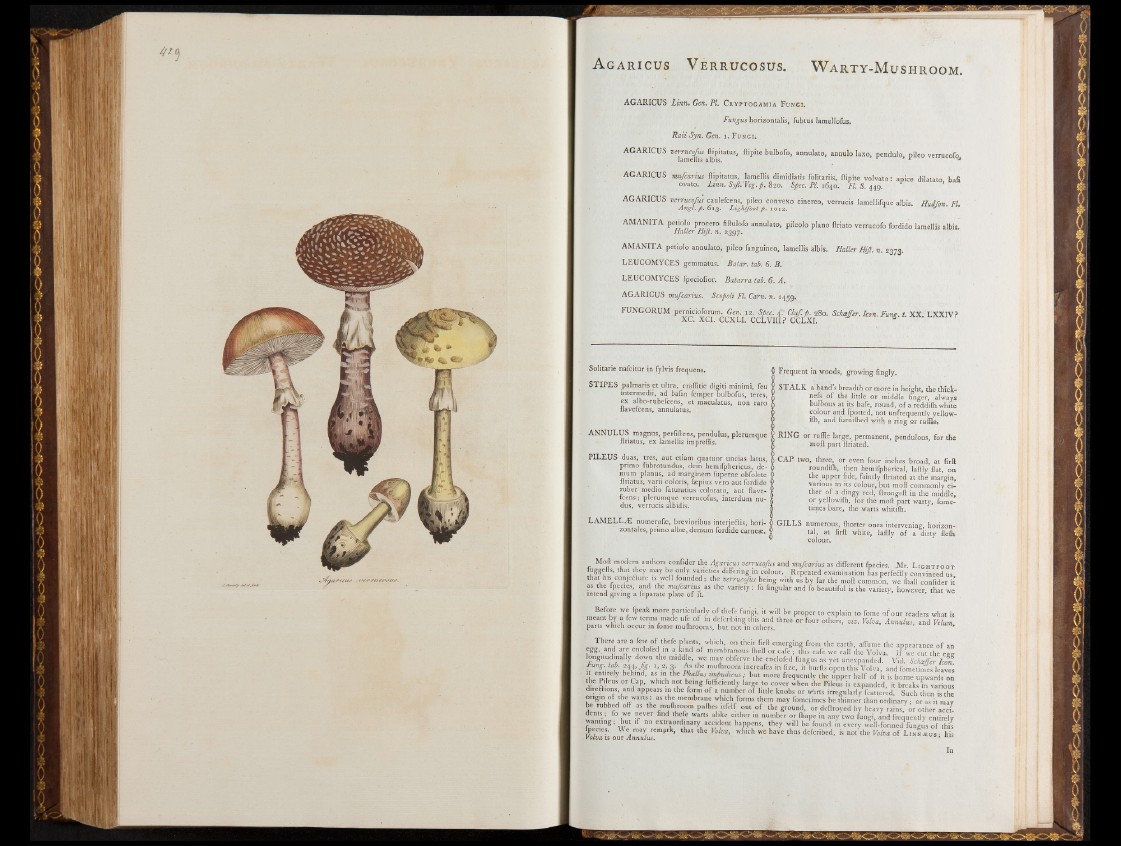
/ / lO j
AGARICUS Linn* Gen. PI. C r y p t o g a m i a F u n g i .
Fungus horizontalis, fubtus lamellofus,
Raii Syn. Gen. 1. F u n g i ; .
AGARICUS verruco/us ftipitatus, flipite bulbofo, annulato, annulo laxo, pendulo, pileo verrucofo
lamellis albis. r *
AGARICUS mufcarius flipitatus, lamellis dimidiatis folitariis, flipite volvato: apice dilatato bafi
ovato. Lmn. SyJl.'Veg. p. 820. Spec. PI. 1640t Fl. S. 449. ’
AGARICUS verruco/us caulefcensy pileo convexo cinereo, verrucis Iamellifque albis. HudFon. FI
Angl. p. 613. JLightfoot p. 1012. J
AMANITA petiolo procero fiftulofo annulato, pileolo piano ftriato verrucofo fordido lamellis albis.
Hauer Hiß. n. 2397.
AMANITA petiolo annulato, pileo fanguineo, lamellis albis. Haller Hiß. n. 2373.
LEUCOMYCES gemmatus. Batar. tab. 6. B.
LEUCOMYCES fpeciofior. Batarra tab. 6. A.
AGARICUS mufcarius. Scopoli FI. Carn.n. 1459.
FUNGORUM,pe™ei„^rum. Gen. ‘ ^ £ < ^ - £ » 8 0 . S u ffe r . Icon. Fung. t. XX. LXXIV?
Frequent in woods, growing fingly.
STALK a hand’s breadth or more in height, the thick-
nefs of the little or middle finger, always
bulbous at its bafe, round, of a reddifh white
colour and fpotted, not unfrequently yellow-
ifh, and furnifhed with a ring or ruffle.
RING or ruffle large, permanent, pendulous, for the
rooft part ftriated.
CAP two, three, or even four inches broad, at firft
roundifh, then hemifpherical, laflly flat, on
the upper fide, faintly ftriated at the margin,
various in its colour, but moft commonly either
of a dingy red, ftrongeft in the middle,
or yellowifh, for the moft part warty, fometimes
bare, the warts whitifh.
Solitarie nafcitur in fylvis frequens. 6
STIPES palmaris et ultra, craflitie digiti minimi, feu 9
GILLS numerous, fhorter ones intervening, horizontal,
at firft white, laflly of a dirty flefh
•colour.
intermedii, ad bafin Temper bulbofus, teres, I
ex albo-rubefcens, et macuiatus, non raro a
flavefcens, annulatus. g
ANNULUS magnus, perfiftens, pendulus, plerumque
ftriatus, ex lamellis impreftis.
PILEUS duas, tres, aut etiam quatuor uncias latus,
primo fubrotundus, dein hemifphericus, de-
mum planus, ad marginem fuperne obfolete
ftriatus, varii coloris, fæpius vero aut fordide
ruber medio faturatius colorato, aut flavefcens
; plerumque verrucofus, interdum nu-
dus, verrucis albidis.
LAMELLÆ numerofæ, brevioribus interje&is, horizontales,
primo albæ, demum fordide carneae.
Moft modern authors confider the Agaricus verruco/us and mufcarius a s different fpecies. Mr. L i g h t f o o t
fuggefts, that theymay be only varieties differing in colour. Repeated examination fas perfeaiy convinced us
that hts conjeaure is well founded; the verruco/us being with us by far the moft common, we [hall confider it
as the fpecies, and the mufcarius as the variety: fo Angular and fo beautiful is the variety, however that we
intend giving a feparate plate of it. 1 *
Before we fpeak more particularly of thefe fungi, it will be proper to explain to fome of our readers what is
meant by a few terms made ufe of in defcnbmg this and three or four others, viz. Volva, Annulus, and Velum
parts which occur m fome mufhrooms, but not in others. . ’ »
There are a few of thefe plants, which, on their firft emerging from the earth, affume'the appearance o f an
egg, and are enclofedin a kind of membranous (hell or cafe; this cafe.we call the Volva. I f we cut the ere
longitudinally down the midd e, we may obferve the enclofed fungus as yet unexpanded. Vid. Scheffer Icon
Fung tab. 244, fig. 1, 2, 3. As the mulhroom tncreafes in fize, it burfts open this Volva, and fometimes leaves
t entirely behind, as m the Phallus mpuduus ; but more frequently the upper half o f it is borne upwards on
the Pileus or Cap, which not being fufhc.ently large to cover when the Pilens is expanded, it breaks in various
direaions, and appears in the Form o f a number of little knobs or wins irregularly flattered. Such then is the
®r,S,n ° f .theffwam • as ^e membrane which forms them may fometimes be thinner than ordinary ; or as it may
be rubbed off as the muftiroom pulhes ttfelf out of the ground, or deftroyed by heavy rains, or other accidents;
fo we never find thefe warts alike either in number or fltape in any two fungi, and frequently entirely
wanting; but if no extraordinary accident happens, they will be found in every well-formed fungus of this
fpecies. We may remark, that the Volva, which we have thus defcribed, is not the Volva o f L in L us - his
Volva is our Annulus. • ’ 1
In